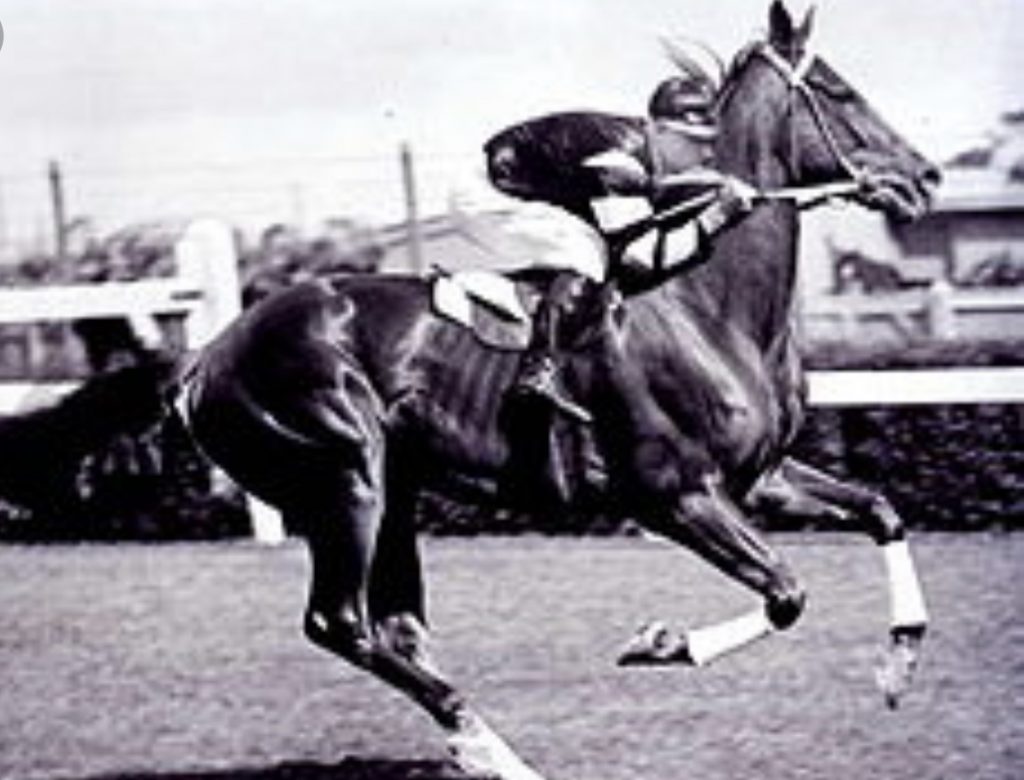
Phar Lap was a great horse on his way to becoming one of the greatest ever.
After a slow start at 2 and 3, he won 14 of 16 races as a 4-year-old in 1930, including the coveted Melbourne Cup, where he carried 138 pounds. He won 8 of 9 in 1931, his only loss coming while carrying an unheard-of 150 pounds in the Melbourne Cup. During one stretch, he won 32 of 35 races.
In 1932, “The Red Terror” traveled to North America and easily won the Agua Caliente Handicap against some of America’s best horses on March 20. He was ready to conquer the rest of the United States.
Two weeks later he was dead.
The Death of Phar Lap
On April 5, 1932, Phar Lap’s groom for the North American trip, Tommy Woodcock, found Phar Lap in severe abdominal pain with a high temperature. A veterinarian diagnosed colic and had Woodcock walk the gelding to prevent the intestines from getting twisted. A few hours later, though, Phar Lap collapsed and died in Woodcock’s arms, blood emanating from his nostrils.
Newspapers the next day cited colic as the cause, brought on by eating green food in a field nearby his stable near Menlo Park, Calif. But rumors began swirling that the horse had been poisoned. He had already been shot at once – the day he won one of three Melbourne Stakes – and guards usually watched him around the clock.
An autopsy revealed an inflamed stomach and intestines, which could have been signs of poisoning. Veterinarian William Nielsen, who performed the post-mortem examination, told the International News Service that he had never seen a horse die so quickly from natural causes. According to his report, some toxic substance caused the symptoms. The official autopsy determined that the horse died through “some poison substance in his stomach.”
Poison in the Insecticide
Experts from the U.S. Bureau of Food and Drugs conducted an investigation and determined that lead arsenate sprayed on oak trees on the ranch was spread by the wind and into the stable of Phar Lap, causing his death. Either poison present in the compound could kill an animal, they said. However, several days later, chemists refuted this report, saying that the amount of arsenic in the horse’s internal organs was not enough to kill him. He did have ulcers, which are now known to be common in horses that are heavily trained and feed on grains.
Did Bacteria Kill Phar Lap?
In their book Phar Lap, authors Geoff Armstrong and Peter Thompson argued that Phar Lap was poisoned, but it was caused by a toxin from the family of bacteria Clostridium. The disease, called duodenitis-proximal jejunitis, seemed to explain all of the horse’s symptoms. Stress, hard racing and especially travel can make a horse susceptible to the bacteria. It kills up to 70 percent of all horses who get it, but it had not been discovered in 1932.
Such a finding would seem to end the controversy – especially 70 years later, but it had only just begun.
A Conspiracy Theory
In 2006, Australian Synchrotron Research scientists determined that Phar Lap was poisoned by a large dose of arsenic administered just hours before his death. This lent credence to the theory that U.S. gangsters, fearful that the colt was a sure bet at the track, killed him to protect their illegal bookmakers.
Two years later, a separate study confirmed that Phar Lap had indeed ingested a large amount of arsenic, based on samples taken from the horse’s mane. However, a less sinister explanation for the arsenic suddenly came to the forefront: an accidental dose from a tonic.
Accidental Poisoning
“In those days, arsenic was quite a common tonic,” Australian veterinarian Percy Sykes told The Eighth Pole in 2018. “It was so common that I’d reckon 90% of the horses had arsenic in their system.” Woodcock swore that Phar Lap was never given any tonic with arsenic in it, but a book from trainer Harry Telford had a recipe for a general tonic. The main ingredient? Arsenic.
Another theory put forth by historian and Phar Lap fan Marion Oster puts the blame on moldy feed. The Australians were so worried about someone poisoning their prized possession that they brought their own feed with them. The feed grew moldy, and the mold killed the horse.
Insecticide? Bacteria? Gangsters? Moldy feed? They’re all theories in one of horse racing’s greatest mysteries. And it may never be solved.
One final note: During the autopsy of Phar Lap, veterinarians weighed the horse’s heart. Its weight was just under 14 pounds, more than 1.5 times larger than the average Thoroughbred’s heart – the heart of a true champion.
Always check with Past the Wire for the latest horse racing news and more…..



